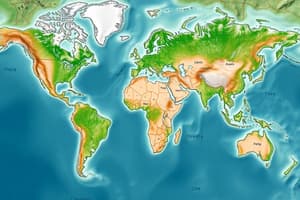Podcast
Questions and Answers
What are some examples of features that can describe a location?
What are some examples of features that can describe a location?
Land use, architectural styles, forms of livelihood, religious practices, political systems, common foods, local folklore, means of transportation, and methods of communication.
Give an example of human-environment interaction.
Give an example of human-environment interaction.
People living in cold climates mining coal or drilling for natural gas to heat their homes.
What are some positive and negative effects of human interaction with the environment?
What are some positive and negative effects of human interaction with the environment?
Positive effects include shaping the landscape and improving human lives. Negative effects include damage to the environment and depletion of resources.
What are some examples of movement studied in geography?
What are some examples of movement studied in geography?
What are the three types of regions?
What are the three types of regions?
How are formal regions defined?
How are formal regions defined?
What defines functional regions?
What defines functional regions?
What are vernacular regions also known as?
What are vernacular regions also known as?
Give an example of a vernacular region.
Give an example of a vernacular region.
What is the purpose of dividing the world into regions for geographic study?
What is the purpose of dividing the world into regions for geographic study?
Define the five themes of geography.
Define the five themes of geography.
Who defined the five themes of geography?
Who defined the five themes of geography?
What is the purpose of the five themes of geography?
What is the purpose of the five themes of geography?
What are the National Geography Standards?
What are the National Geography Standards?
What is the difference between absolute and relative location?
What is the difference between absolute and relative location?
Give an example of absolute location.
Give an example of absolute location.
Give an example of relative location.
Give an example of relative location.
What does place describe?
What does place describe?
Give an example of a physical characteristic of a place.
Give an example of a physical characteristic of a place.
Give an example of a human characteristic of a place.
Give an example of a human characteristic of a place.
Flashcards are hidden until you start studying




